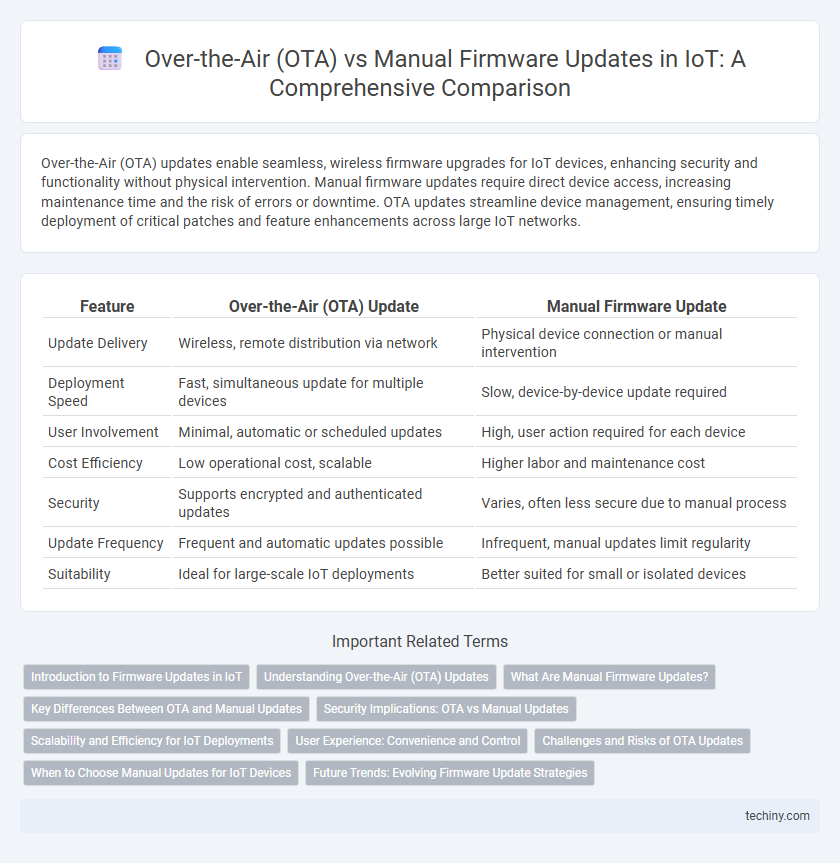Over-the-Air (OTA) updates enable seamless, wireless firmware upgrades for IoT devices, enhancing security and functionality without physical intervention. Manual firmware updates require direct device access, increasing maintenance time and the risk of errors or downtime. OTA updates streamline device management, ensuring timely deployment of critical patches and feature enhancements across large IoT networks.
Table of Comparison
| Feature | Over-the-Air (OTA) Update | Manual Firmware Update |
|---|---|---|
| Update Delivery | Wireless, remote distribution via network | Physical device connection or manual intervention |
| Deployment Speed | Fast, simultaneous update for multiple devices | Slow, device-by-device update required |
| User Involvement | Minimal, automatic or scheduled updates | High, user action required for each device |
| Cost Efficiency | Low operational cost, scalable | Higher labor and maintenance cost |
| Security | Supports encrypted and authenticated updates | Varies, often less secure due to manual process |
| Update Frequency | Frequent and automatic updates possible | Infrequent, manual updates limit regularity |
| Suitability | Ideal for large-scale IoT deployments | Better suited for small or isolated devices |
Introduction to Firmware Updates in IoT
Firmware updates in IoT devices are critical for enhancing functionality, fixing security vulnerabilities, and improving system performance. Over-the-Air (OTA) updates enable remote deployment of new software versions without physical device access, ensuring timely and scalable maintenance. In contrast, manual firmware updates require physical connection to each device, often leading to increased labor costs and delayed rollout of essential patches.
Understanding Over-the-Air (OTA) Updates
Over-the-Air (OTA) updates enable remote firmware upgrades for Internet of Things (IoT) devices via wireless connections, eliminating the need for physical access and reducing downtime. OTA updates enhance device security by promptly deploying critical patches and feature enhancements, ensuring continuous operation and compliance with evolving standards. Compared to manual firmware updates, OTA offers scalable, efficient management of large IoT networks with minimal human intervention and operational disruption.
What Are Manual Firmware Updates?
Manual firmware updates require physical access to IoT devices, often involving connection via USB or serial ports to load new software versions. These updates can be time-consuming and prone to human error, limiting scalability for large IoT deployments. Despite this, manual updates may be necessary for devices without network connectivity or in highly secure environments where OTA updates pose risks.
Key Differences Between OTA and Manual Updates
Over-the-Air (OTA) updates enable remote, wireless firmware installation, significantly reducing downtime and manual intervention compared to manual firmware updates that require physical access to each Internet of Things (IoT) device. OTA updates improve scalability by simultaneously deploying patches across large IoT networks, whereas manual updates are time-consuming and prone to human error. Security is enhanced with OTA mechanisms through encrypted transmissions and automated rollback features, contrasting with the increased risk of tampering during manual update processes.
Security Implications: OTA vs Manual Updates
Over-the-Air (OTA) updates enhance IoT security by enabling rapid deployment of critical patches, minimizing exposure to vulnerabilities compared to manual firmware updates prone to delays and human error. OTA processes often use encryption and authentication protocols to prevent unauthorized access, whereas manual updates risk exposure through physical access or insecure transport methods. The automated and scalable nature of OTA updates reduces the attack surface and ensures consistent security enforcement across distributed IoT devices.
Scalability and Efficiency for IoT Deployments
Over-the-Air (OTA) updates enable scalable management of firmware across vast IoT networks by automating the process, reducing the need for manual intervention and minimizing downtime. Manual firmware updates are labor-intensive, prone to errors, and lack efficiency, making them impractical for large-scale IoT deployments. OTA updates optimize resource allocation and ensure consistent security and performance across devices, significantly enhancing operational efficiency in expanding IoT ecosystems.
User Experience: Convenience and Control
Over-the-Air (OTA) updates enhance user experience by enabling seamless, remote firmware upgrades without requiring physical device access, providing unmatched convenience and minimizing downtime. Manual firmware updates offer users greater control by allowing selective installation times but can be cumbersome, requiring technical knowledge and direct device connection. Balancing convenience and control depends on the IoT deployment's scale and user technical proficiency, with OTA favored for large-scale, automated environments and manual updates suited for critical, hands-on management scenarios.
Challenges and Risks of OTA Updates
Over-the-Air (OTA) updates in the Internet of Things (IoT) present challenges such as potential security vulnerabilities during wireless transmission, risking unauthorized access or malware injection. Network reliability issues can lead to incomplete updates, causing device malfunction or bricking. Managing diverse device compatibility and ensuring update integrity across heterogeneous IoT environments complicate OTA deployment compared to manual firmware updates.
When to Choose Manual Updates for IoT Devices
Manual firmware updates for IoT devices are preferable in environments with limited or unstable network connectivity, ensuring reliability without dependency on OTA infrastructure. Devices with stringent security requirements benefit from manual updates, as they allow controlled and authenticated installation processes reducing the risk of unauthorized access. In scenarios involving legacy hardware or critical systems where OTA compatibility is absent or risky, manual updates provide a safe alternative to guarantee device integrity and operational stability.
Future Trends: Evolving Firmware Update Strategies
Over-the-Air (OTA) updates in the Internet of Things (IoT) ecosystem are increasingly favored due to their ability to enable remote, efficient, and scalable firmware management, reducing downtime and operational costs. Future trends indicate a rise in AI-driven OTA update strategies that predict and preemptively fix vulnerabilities, ensuring enhanced security and device longevity. Manual firmware updates, while still relevant in legacy systems, are expected to diminish as industries move towards autonomous, real-time update frameworks integrated with edge computing and blockchain for tamper-proof delivery.
Over-the-Air (OTA) Update vs Manual Firmware Update Infographic

 techiny.com
techiny.com